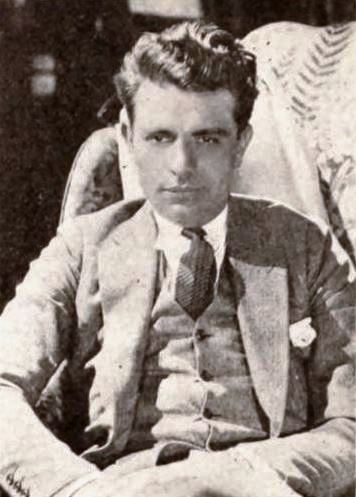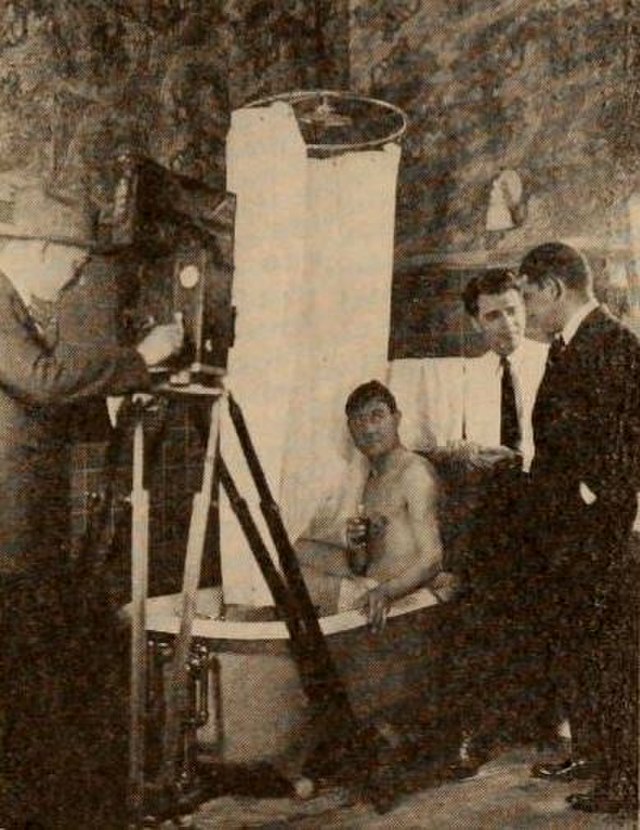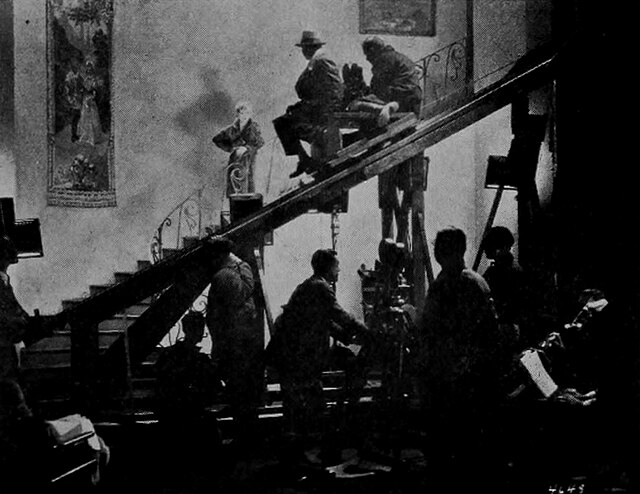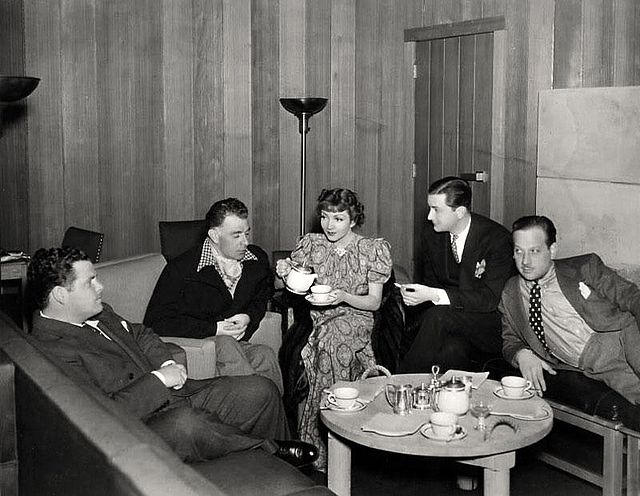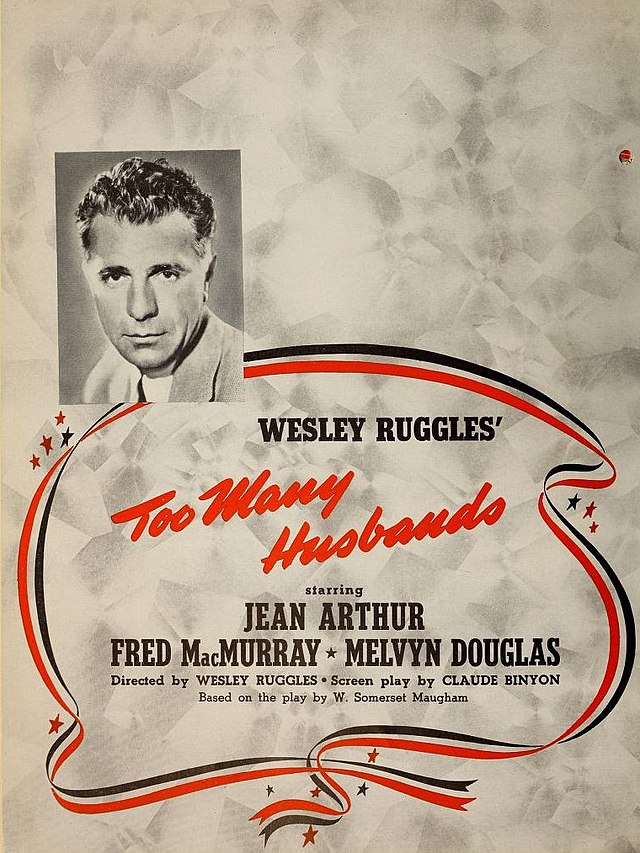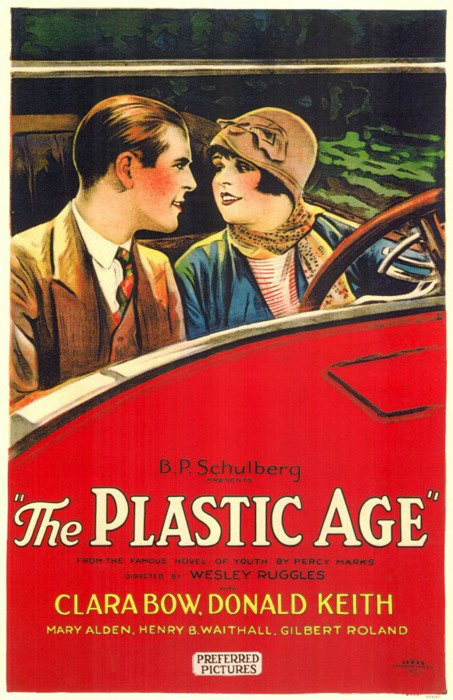Wesley Ruggles
back| Full Name | Wesley Ruggles |
| Born | June 11, 1889 |
| Birthplace | Los Angeles, California, USA |
| Died | January 8, 1972 |
| Buried | Forest Lawn Memorial Park (Glendale), California, USA |
| Married to | Dorothy Patterson (m. 1919–1924, divorced) - Marian Constance Blackton (m. 1924–1926, divorced) - Arline Judge (m. 1931–1937, divorced) - Marcelle Rogez (m. 1937–1940, divorced) - Virginia Haralson (m. 1940–his death in 1972) |
| Children | No children |
| Notable films | Cimarron (1931) - I'm no Angel (1933) - Bolero (1934) - College Humor (933) - True Confession (1937) |
Wesley Ruggles
The Versatile Craftsman
Wesley Ruggles was a versatile American film director known for his work from the silent film era to the golden age of Hollywood. Born in Los Angeles, he transitioned from acting to directing in the 1920s.
Ruggles' breakthrough came with Cimarron (1931), which won the Academy Award for Best Picture. He excelled in various genres, directing notable films like I'm No Angel (1933) and True Confession (1937).
Related
Wesley Ruggles (1889 – 1972)
Biography and Career Overview
Wesley Ruggles was an influential American film director whose career spanned the silent film era into the golden age of Hollywood. Born in Los Angeles, California, Ruggles began his career in the film industry as an actor before transitioning to directing.
Early Life and Career
Wesley Ruggles was born on June 11, 1889, into a family already involved in the entertainment industry. His older brother, Charles Ruggles, would also become a well-known actor. Wesley started his career in the early 1910s, appearing in various silent films. However, his interest quickly shifted to directing, and by the 1920s, he had directed numerous silent films.
Breakthrough and Success
Ruggles' major breakthrough came with the advent of sound in cinema. In 1931, he directed Cimarron, a Western epic that won the Academy Award for Best Picture. The film's success established him as a prominent director in Hollywood. His ability to handle large-scale productions and complex narratives was highly regarded.
Throughout the 1930s, Ruggles directed several notable films. I'm No Angel (1933) starred Mae West and was a major box office hit, showcasing his skill in directing comedies. He also directed College Humor (1933) and Bolero (1934), which further solidified his reputation.
Personal Life
Wesley Ruggles' personal life was marked by multiple marriages. He was married five times, each marriage ending in divorce except his last. His first marriage was to Dorothy Patterson in 1919, which ended in 1924. He then married Marian Constance Blackton, Arline Judge, and Marcelle Rogez, all of which also ended in divorce. In 1940, he married Virginia Haralson, and they remained together until his death. Ruggles did not have any children from any of his marriages.
Later Years and Legacy
Ruggles continued to work in the film industry into the 1940s, though his later films did not achieve the same level of acclaim as his earlier works. He retired from directing in the 1950s but remained a respected figure in Hollywood for his contributions to the industry.
Wesley Ruggles passed away on January 8, 1972, in Santa Monica, California. He was buried at Forest Lawn Memorial Park in Glendale, California. Ruggles' legacy lives on through his influential films, particularly Cimarron, which remains a significant part of American cinematic history.
Wesley Ruggles' career is a testament to his versatility and talent as a director, and his films continue to be appreciated by audiences and film historians alike.
Excerpt from The Sea Bat:
Versatile Directing Style of Wesley Ruggles:
Wesley Ruggles was a versatile director who worked across a variety of genres throughout his career. His ability to adapt his style to suit different types of films contributed to his longevity and success in Hollywood. Here’s an analysis of the key elements that defined his directing style:
Genre Versatility
Ruggles directed films across a wide range of genres, including Westerns, comedies, dramas, and musicals. This versatility is one of his most defining characteristics. He was able to seamlessly transition between genres, bringing a unique touch to each:
- Westerns: Cimarron (1931) showcased his ability to handle large-scale epics with complex narratives and extensive use of location shooting.
- Comedies: Films like I'm No Angel (1933) and True Confession (1937) highlighted his skill in comedic timing and handling of star personas, particularly Mae West and Carole Lombard.
- Dramas: His work in dramas such as Valiant Is the Word for Carrie (1936) displayed his talent for character-driven stories and emotional depth.
Focus on Strong Characters and Performances
Ruggles had a knack for drawing strong performances from his actors. He often worked with big stars of the era and managed to bring out nuanced and memorable performances. He had a particular talent for:
- Developing Complex Characters: He often focused on the intricacies of his characters' personalities and moral dilemmas, as seen in Cimarron and Valiant Is the Word for Carrie.
- Star Vehicles: Ruggles effectively utilized the star power of actors like Mae West, Clark Gable, Carole Lombard, and Bing Crosby, tailoring his direction to showcase their unique talents.
Narrative Structure and Pacing
Ruggles' films were known for their well-structured narratives and effective pacing:
- Clear Storytelling: He maintained a clear and engaging storyline, ensuring that the plot was accessible and compelling to the audience.
- Pacing: Ruggles had a keen sense of pacing, balancing dramatic tension with moments of levity, especially in his comedies and action sequences.
Visual Style and Use of Cinematography
Ruggles' visual style, while not as distinct or avant-garde as some of his contemporaries, was effective and contributed to the storytelling:
- Realistic Sets and Locations: He often used realistic sets and locations to ground his stories in a believable context, particularly evident in Cimarron, which used extensive location shooting to enhance the epic scale of the film.
- Framing and Composition: His use of framing and composition was functional, focusing on clarity and enhancing the actors' performances. He preferred clean, straightforward compositions that served the narrative.
Integration of Music and Sound
In the transition from silent films to talkies, Ruggles adeptly incorporated sound into his films:
- Musicals and Comedies: His musicals and comedies, like College Humor and Sing You Sinners, featured well-integrated musical numbers that were essential to the plot rather than mere interludes.
- Sound Design: Ruggles used sound design to enhance the atmosphere and emotional impact of his scenes, adapting quickly to the technological advancements of his time.
Adaptation of Source Material
Ruggles often worked on adaptations, bringing literary and stage works to the screen with sensitivity and respect for the source material:
- Faithful Adaptations: He was known for his faithful adaptations, such as The Four Feathers (1929) and The Robe (1953), ensuring that the essence of the original works was preserved while making them accessible to film audiences.
- Character and Plot Development: His adaptations often featured well-developed characters and plots that retained the complexity of the source material.
Wesley Ruggles' directing style was characterized by his versatility, focus on strong characters and performances, clear narrative structure, effective use of cinematography, and integration of music and sound. His ability to work across multiple genres and adapt to the changing landscape of Hollywood cinema made him a respected and influential director in the early to mid-20th century. His films continue to be appreciated for their craftsmanship and storytelling, reflecting the broad range of his directorial skills.
Awards and Recognition:
Academy Awards
- 1931: Cimarron
Nominated: Best Director
Won: Best Picture (as director of the film, though the award officially went to the producers, it was a significant recognition of his work)
Other Notable Recognitions
While Wesley Ruggles did not accumulate a large number of awards during his career, his work, particularly on Cimarron, earned him critical acclaim and recognition within the film industry. The film's success at the Academy Awards in 1931, where it won the Oscar for Best Picture, marked a high point in his career and solidified his reputation as a talented director.
Ruggles' contributions to cinema, especially during the transition from silent films to talkies, were significant, and his ability to direct across various genres was highly respected. However, detailed records of other specific awards or nominations he may have received beyond the Academy Awards are not as widely documented.
Personal Quotes from Wesley Ruggles:
· On Filmmaking:
"A director must be both an artist and a craftsman. It's about telling a story that resonates with people, and doing so with skill and dedication."
· On the Importance of Story:
"The heart of a great film is its story. Special effects and star power can enhance it, but without a compelling story, the film will never truly connect with the audience."
· On Working with Actors:
"Directing actors is about trust and collaboration. You need to give them space to bring their characters to life while guiding them towards the vision of the film."
· On Adaptation:
"When adapting a book or a play, it's crucial to respect the source material while also recognizing the unique strengths and demands of the cinematic medium."
· On His Career:
"I've been fortunate to work in an industry I love, and to tell stories that I believe in. Every film is a new challenge and an opportunity to create something meaningful."
Movies directed by Wesley Ruggles:
- 1920: The Leopard Woman
Synopsis: A British explorer meets a mysterious African woman while on an expedition. Intrigue and romance ensue as they navigate the dangers of the jungle.
- 1921: The Woman God Changed
Synopsis: A young woman transforms her life after meeting a man who believes in her potential, leading to dramatic changes and new opportunities.
- 1921: The Call of the North
Synopsis: A rugged frontiersman is drawn into a struggle for survival and justice in the harsh Canadian wilderness.
- 1922: Find the Woman
Synopsis: A detective investigates a mysterious disappearance, uncovering a web of deceit and betrayal.
- 1923: The Huntress
Synopsis: A young woman disguises herself as a man to escape her past and becomes an adept hunter, facing challenges and finding love along the way.
- 1923: The Man Life Passed By
Synopsis: A man down on his luck finds hope and redemption through unexpected friendships and personal growth.
- 1923: The Age of Desire
Synopsis: A romantic drama exploring the complexities of love, ambition, and societal expectations.
- 1924: The Mirage
Synopsis: A man stranded in the desert encounters a beautiful woman who may be a figment of his imagination or his salvation.
- 1924: True As Steel
Synopsis: A woman proves her mettle in a male-dominated industry, facing challenges with determination and integrity.
- 1924: Her Love Story
Synopsis: A romantic tale of a woman torn between her love for two men and the societal pressures she faces.
- 1924: The Triflers
Synopsis: A drama centered around the lives of several individuals whose seemingly trivial actions have significant consequences.
- 1924: The Rejected Woman
Synopsis: A woman scorned by society seeks revenge and ultimately finds redemption through unexpected means.
- 1925: The Plastic Age
Synopsis: A coming-of-age story about college life, romance, and the challenges of growing up.
- 1925: The Ancient Mariner
Synopsis: An adaptation of the famous poem by Samuel Taylor Coleridge, following a sailor's harrowing journey and his encounter with the supernatural.
- 1925: Wild, Wild Susan
Synopsis: A comedic adventure featuring a spirited young woman who gets into various escapades.
- 1925: The Coast of Folly
Synopsis: A woman caught in a love triangle must navigate the complexities of her emotions and societal expectations.
- 1925: Soul-Fire
Synopsis: A musician's passion for his art drives him to the brink of obsession, affecting his personal relationships.
- 1926: Miss Nobody
Synopsis: A young woman rises from obscurity to prominence, facing numerous challenges along the way.
- 1926: Camille of the Barbary Coast
Synopsis: A love story set against the backdrop of San Francisco's notorious Barbary Coast, featuring a dance hall girl and her struggle for a better life.
- 1926: Sporting Youth
Synopsis: A comedy about a young man who gets involved in the world of auto racing, leading to humorous and thrilling situations.
- 1927: Love's Greatest Mistake
Synopsis: A drama about a woman who must confront the consequences of a past romantic decision.
- 1927: The Heart Thief
Synopsis: A charming rogue steals hearts and purses, finding unexpected romance and redemption.
- 1927: Casey at the Bat
Synopsis: A comedic take on the famous poem about a baseball player's rise and fall.
- 1927: The Cheerful Fraud
Synopsis: A lighthearted comedy about a man who pretends to be someone he's not, leading to humorous situations and eventual love.
- 1927: Knockout Reilly
Synopsis: A boxing drama about an underdog fighter who rises to prominence, facing personal and professional challenges.
- 1928: The Blue Danube
Synopsis: A romantic drama set to the backdrop of Johann Strauss's famous waltz, exploring love and longing.
- 1928: The Lady of Victories
Synopsis: A historical drama centered around a woman who becomes a symbol of hope and resilience during a time of conflict.
- 1928: Somewhere in Sonora
Synopsis: A Western adventure about a man seeking justice and revenge in the rugged landscape of Sonora.
- 1929: The Four Feathers
Synopsis: An adaptation of the classic adventure novel about a young British officer accused of cowardice and his journey to redeem himself.
- 1929: The Awful Truth
Synopsis: A comedy of errors involving a couple's attempts to prove their fidelity while going through a divorce.
- 1930: The Sea Bat
Synopsis: A thriller set on a remote island where a giant sea bat terrorizes the inhabitants, leading to a battle for survival.
- 1931: Cimarron
Synopsis: A sweeping epic about the Oklahoma land rush and the pioneering spirit of a family striving to build a life on the frontier. The film won the Academy Award for Best Picture.
- 1932: Are You Listening?
Synopsis: A dramatic tale about the lives of radio station employees and the intertwining personal and professional conflicts they face.
- 1932: No Man of Her Own
Synopsis: A romantic drama starring Clark Gable and Carole Lombard about a con man and a librarian who fall in love under unusual circumstances.
- 1932: Helpmates
Synopsis: A short comedy film starring Laurel and Hardy, featuring the duo's hilarious attempts to clean up a house after a wild party.
- 1933: College Humor
Synopsis: A musical comedy set in a college, featuring love triangles, pranks, and the ups and downs of student life.
- 1933: I'm No Angel
Synopsis: A comedy starring Mae West as a circus performer who climbs the social ladder through a series of romantic entanglements.
- 1934: Bolero
Synopsis: A romantic drama about a dancer's rise to fame and the personal sacrifices she makes along the way.
- 1934: Shoot the Works
Synopsis: A musical comedy about a carnival barker who dreams of hitting the big time with his variety show.
- 1934: Miss Fane's Baby Is Stolen
Synopsis: A gripping drama about a movie star whose child is kidnapped, leading to a tense and emotional rescue mission.
- 1935: Accent on Youth
Synopsis: A romantic comedy about a playwright who falls in love with his much younger secretary, leading to complications and humor.
- 1936: Vieni con me, amore! (Come with Me, Love!)
Synopsis: An Italian romantic drama exploring the complexities of love and relationships.
- 1936: Valiant Is the Word for Carrie
Synopsis: A drama about a woman of questionable morals who redeems herself by helping two troubled children.
- 1937: True Confession
Synopsis: A screwball comedy starring Carole Lombard as a woman who falsely confesses to a crime to help her struggling lawyer husband.
- 1938: Sing You Sinners
Synopsis: A musical comedy about three brothers with different dreams, featuring Bing Crosby as the lead.
- 1939: Invitation to Happiness
Synopsis: A sports drama about a boxer who must balance his career ambitions with his personal life and relationships.
- 1940: Too Many Husbands
Synopsis: A romantic comedy about a woman who finds herself with two husbands and the ensuing humorous complications.
- 1940: Arizona
Synopsis: A Western drama set in the 1860s, following a strong-willed woman who builds a freight business in the Arizona Territory.
- 1941: You Belong to Me
Synopsis: A romantic comedy about a doctor who marries a millionaire and the challenges they face balancing their professional and personal lives.
- 1942: True to the Army
Synopsis: A musical comedy about a group of Army recruits and their humorous adventures during basic training.
- 1942: A Yank at Eton
Synopsis: A comedy-drama about an American boy sent to an elite British boarding school, where he faces cultural clashes and personal growth.
- 1943: Slightly Dangerous
Synopsis: A romantic comedy about a small-town girl who reinvents herself in the big city and finds love and adventure.
- 1943: See Here, Private Hargrove
Synopsis: A comedy based on the bestselling book about the humorous experiences of a naive soldier in the U.S. Army during World War II.
- 1952: The Milkman
Synopsis: A comedy about a man who becomes a milkman to impress a girl, leading to a series of humorous misadventures.
- 1953: The Robe
Synopsis: An epic biblical drama about a Roman tribune who is involved in the crucifixion of Jesus and his subsequent conversion to Christianity.

